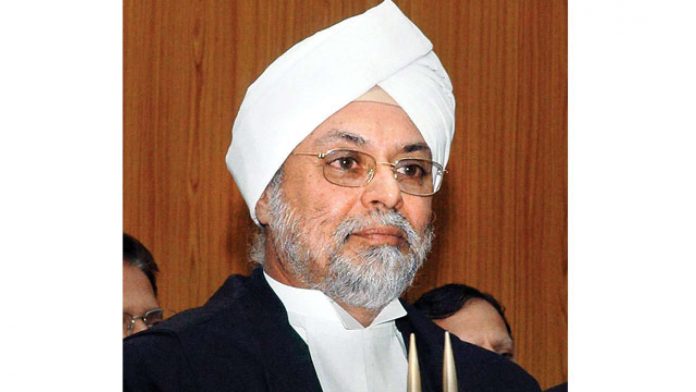This article is written by Niharika Agrawal pursuing BBA LLB from IFIM Law School Bangalore. This article has analysed previous judgements that have questioned the reign of Justice Khehar as the Chief Justice of India.
Table of Contents
Introduction
Justice is made based on moral rightness, rationality, equity, and fairness and the burden of delivering such timely justice to the citizens of the country is upon the Supreme Judge of the country. In India, the major role of the Supreme Judge is by the Chief Justice of India. Justice Jagdish Singh Khehar was appointed as 44th Chief Justice of India on the 4th of January by the then President of India, Pranab Mukherjee. He has succeeded Justice T. S. Thakur and worked in the position for a short period, i.e., from January 2017 to August 2017. He was the first Sikh Chief Justice of India. However, his appointment for the position of Chief Justice of India was challenged by the group of lawyers by filling the petition in the Supreme Court of India in the case of National Lawyers’ Campaign for Judicial Transparency & Reforms & Others v. Hon’ble Shri Justice J.S. Khehar & Others (2016).
This article deals with the challenges faced by Justice Khehar during his appointment for the said position in the light of the above-mentioned case.
Analysis of the case
The origin of the present case is from the past judgement given in the case of Supreme Court v. Union of India (2015), also known as the NJAC case. This judgement was given by a five-judge bench, headed by Justice Khehar. With a majority of 4:1 ratio, it was held that the 99th Amendment to the Constitution is void as it is ultra vires to the Constitution. The judges were of the opinion that the appointment of judges cannot be compromised as it is an important part of the primacy of the judiciary. According to them, handing over the power to appoint judges of higher judiciary in the hands of National Judicial Appointment Commission (NJAC) under Article 124 (A), and the power to Parliament for regulating the procedures and to set the manner of selection under Article 124 (C) is unconstitutional, as it is a potential threat and impinge upon the independence of the judiciary in India.
The Apex Court also held that the doctrine of basic structure cannot apply while judging the validity of the Parliament Statute, independence of the judiciary and the rule of law, as that may affect the golden triangle of the Constitution, i.e., the fundamental rights under Article 14, Article 19 and Article 21 of the Indian Constitution. Thus the NJAC Act was struck down as the Supreme Court of India was given the power to review any amendment that violates the basic structure of the Constitution.
The present writ petition was filed under Article 32 of the Constitution by the National Lawyers Campaign for Judicial Transparency and Reforms and fifteen other persons for the elevation of his position of Chief Justice of India. According to them, Justice Khehar struck down the NJAC to benefit himself, as the judgement has reviewed the collegium system for the appointment of judges in the higher judiciary. They also claimed that he was more biased towards the high profile lawyers and was strict against the minor errors committed by advocates. According to them, the NJAC Act gives the government an equal say and chance in the process of appointment of judges. Hence the group of lawyers alleged that Justice Khehar is not eligible for the post of Chief Justice of India on the ground that the NJAC case, which was delivered under his Lordship, has declared that 99th Amendment of the Constitution and NJAC Act, 2014 as unconstitutional and void, in order to benefit himself with illegal power of appointing the judges.
Justice Khehar also headed the bench that forced the government to withdraw the Presidential rule in Arunachal Pradesh in January 2015. He alleged that all the actions of the Governor are violative of the Constitution which has impacted the power of executives. Due to this various questions were raised on the eligibility of Justice Khehar as Chief Justice of India. Apart from these allegations, the petitioners have also praised the qualities of the Justice. They stated that Justice Khehar is a tall judge with undoubted integrity, honesty and uprightness and calls his lordship a real diamond. The petitioners were of the view that Justice Chelameswar, the second senior-most Judge, should be the succeeding Chief Justice of India as he had a dissenting view in the NJAC case of upholding the constitutional validity of the Act and also favoured the scraping of collegium system for appointment of judges in the higher judiciary.
Due to this Justice Khehar has to face various challenges of being a Chief Justice of India. The following were the challenges.
- The Memorandum of Procedure (MoP)
One of the major challenges that Justice Khehar has faced was concerning re-drafting of the MoP that finalises the procedure for the appointment of judges to the higher judiciary. Justice Khehar decided to re-draft the old two decades of MoP with the intention to bring transparency and accountability in the judicial appointment process. By declaring NJAC Act unconstitutional, he tried to provide a new version of the collegium system. However, Justice Chelameswar was against the judgement as he felt it criticizes the spirit of the Constitution. According to him, it is impossible to have independence from any of the three branches due to democratic values and provisions under the Constitution of India.
The objective of the 99th Amendment is only to restore the balance between the branches and hence, this cannot be destructive of the basic structure of the Constitution. Thus, he refuses to attend any meeting related to collegium until the process is evolved to bring transparency in the process of appointment. This MoP is the bone of contention between the Centre and the Supreme Court. This was the first challenge before the new Chief Justice of India to remove all the predicament through addressing the issues of transparency and accountability in the functioning of the collegium.
- Delay in filling vacancies
The collegium system consists of five senior-most judges of the Apex Court to make recommendations to the government for appointing the judges for higher judiciary. Delay in filling the vacancies in the sanctioned strength of the courts also increases the institution of the cases which renders the inadequacy in the judiciary to deliver its constitutional mandates. Due to the inadequate state of the courts, the Government Committees and the Commissions find arrears in the court’s functioning. These bodies of the government, therefore, opined to increase the strength of the judges for a long time, but to date, it has remained unimplemented. The courts in this situation are unable to deliver the fundamental right to timely justice to the people at large and thus it undermines the major purpose of judicial independence and constitutionalism. Hence, this is the second biggest challenge to the new Chief Justice of India to develop the relationship where the appointment process moves smoothly.
Till today there has not been any such scale that resolved the present judicial crisis. There have been continuous questions regarding the initiative taken by the judiciary to ensure more transparency and accountability in the judicial system, from the government and the civil society. The Chief Justice, who is the Paterfamilias of the judiciary, while taking any decisions in the judicial capacity has to initiate some positive and reformative changes, or else, the judiciary under the largest democracy will succumb under the force of its own responsibility, which would bring forth an even more challenging issue of bringing back the faith of people in the judiciary.

Judgement
The Supreme Court consists of the Vacation Bench of Justice R. K. Agrawal and Justice D. Y. Chandrachud in the petition against Justice Khehar refused to entertain the petition due to insufficient and unreasonable grounds. The Court held that the collegium system not only consisted of Justice Khehar but also the other four senior-most judges. Hence, it is not correct to state that Justice Khehar has benefited himself from his verdict in the NJAC case.
The Apex court also pointed out that the petitioner has himself praised Justice Khehar and his honesty and integrity in the present petition and therefore, no question arises of his eligibility or being disqualified for appointment as Chief Justice of India.
Further, the bench also clarified that the petitioner has the remedy to file a review and curative petition whenever there are questions of the correctness of the decision of the court, for example, the judgement in the case of NJAC. Both judges on the bench, with their reasonings, held that the disqualification of Justice Khehar for being Chief Justice of India is thoroughly misconceived. Justice Kehar was duly appointed by the then President of India as a judge of the Supreme Court under Article 124(2) of the Constitution on 13th September 2011. Being the senior-most judge of the Apex Court, he is allowed to appoint as a Chief Justice of India as per the Constitutional convention.
Conclusion
Thus, Justice J. S. Khehar had commenced his position in the Chief Justice of India office on 4th January 2017 for a term of seven months along with a discourteous summer vacation of one and half months. He retired on 27th August 2017. In this short duration, it is not possible to resolve all the issues and neither person could accomplish his or her dream. It has been the old ritual that the senior-most person would be the head, similarly, in the world of law, a similar old tradition is followed where the senior-most judge is awarded as the Chief Justice of India. Thus, the question related to the functionality of the ritual has also become relevant. In the absence of any Constitutional provision, this convention was provided with exceptions so that any controversies arising out of the appointment of the Chief Justice of India can be avoided. However, this has led to a rapid succession of CJIs within two or three months. This was another problem with the judiciary. In the Apex Court, the entire power is given in the hands of CJIs and if there is the absence of fixed tenure, there can be no developments and reforms for judiciary independence from the executive on aspects other than the appointment of the CJIs.
References
- http://www.jlapp.in/case-commentary-the-njac-judgement/
- https://timesofindia.indiatimes.com/india/sc-turns-down-plea-against-elevation-of-justice-js-khehar-as-cji/articleshow/56137039.cms
- https://scroll.in/latest/825519/supreme-court-dismisses-plea-against-jagdish-singh-khehars-appointment-as-next-chief-justice
- https://www.thehindu.com/news/national/Plea-against-appointment-of-Justice-Khehar-as-CJI-dismissed/article16963735.ece
- https://www.business-standard.com/article/pti-stories/njac-verdict-can-t-be-used-as-ruse-to-interdict-cji-khehar-sc-117012200638_1.html
- https://www.livemint.com/Politics/UlzNPp5d7DhABJKcdlJAGN/J-S-Khehar-appointed-as-next-chief-justice-of-India.html
- https://www.thehindu.com/news/national/Jagdish-Singh-Khehar-sworn-in-as-Chief-Justice-of-India/article16986757.ece
- https://www.legitquest.com/case/national-lawyers-campaign-for-judicial-transparency-reforms-others-v-honble-shri-justice-js-khehar/A9D0D
LawSikho has created a telegram group for exchanging legal knowledge, referrals and various opportunities. You can click on this link and join:
https://t.me/joinchat/J_0YrBa4IBSHdpuTfQO_sA
Follow us on Instagram and subscribe to our YouTube channel for more amazing legal content.











